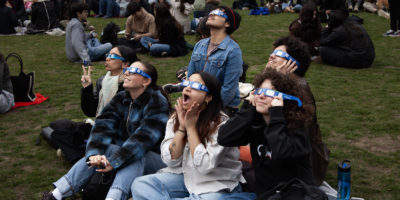By Justin Chandler
Mario may not be the only one eating mushrooms in space.
Third-year Ryerson students Komalpreet Kahlon, Gemma Mancuso and Francis Buguis are part of a team that won the chance to send an experiment to the International Space Station (ISS). The experiment, which should be launched in late March, will test how oyster mushrooms grow in microgravity.
“[Oyster mushrooms] could potentially be a food source that astronauts could grow for themselves in space. They’re easy to grow,” Mancuso, a biomedical science student, said.
Because they are high in fibre, low in fat and can grow from waste such as used coffee grounds and cardboard, oyster mushrooms might be a good regenerating food source on long-term space missions, the team said.
Kahlon, Mancuso and Buguis designed their experiment for the Ryerson Student Spaceflight Experiments Program (SSEP), a competition in which Ryerson undergraduates teamed up with high school students to design an experiment that could study the effect of microgravity on a physical, chemical or biological system. About 90 students competed.
Ryerson’s competition was one of 14 SSEPs held across North America this year and the first SSEP held in Canada.
The SSEP initiative is run by the National Center for Earth and Space Science Education (NCESSE), an American educational organization.
With Grade 11 students Kugenthini Tharmalulasekaram and Modlin Orange, Kahlon, Mancuso and Buguis made up Team U, one of the 26 teams that competed at Ryerson. The top three experiments from each community hosting an SSEP were sent to the NCESSE in the spring. The organization picked a winner in each community. Team U was the winner at Ryerson.
Koivisto said he thinks the NCESSE picked Team U’s proposal because it provided more “insight for humanity” than the other two sent by Ryerson.
“The biggest problem, in the beginning, was finding something that would survive and was stable when it was out of our hands, and would be preserved by the time it gets back to us,” biomedical-science student Buguis said. He said the oyster mushroom’s spores are resistant to drying and heat.
Kahlon, who studies medical physics, said the spores Team U sends up will remain dormant and not need nutrients until they reach the ISS and are activated for the experiment.
The team does not know which direction the fungus’ mycelia (similar to plant roots) will grow, Kahlon said.
They also don’t know if the fungus will be able to extract the water and nutrients it needs without standard Earth gravity.
When it goes into space, Team U’s experiment will be contained in an 8.4 ml tube separated into three compartments by clamps. One compartment will hold mushroom spores and rice straw for them to eat and grow on. Another will hold water gel crystals to hydrate the spores. A third will hold an agent to kill the fungus once it has grown for about two weeks. This ensures all growth will occur in space. The dead fungus will remain preserved in the tube so Team U can analyze it when it returns to Earth.
Team U was only allowed to give two minutes of instructions to the astronauts on the ISS. The first step is to open the clamp separating the water gel crystals from the spores and rice straw and then gently shake the tube for a minute, which should trigger the growth of the mushrooms. The second step, which should take place about two weeks later, is to open the second clamp and shake the tube for a minute to kill and preserve the fungus.
When the experiment tube returns to Team U, they will compare its growth to a controlled experiment they conducted on Earth.
“Even if there is less growth, but there is growth, that still shows a lot of promise,” Kahlon said. That would still mean oyster mushrooms can grow in microgravity.
With the launch about four months away, Team U is working to grow the microscopic spores they will send to the ISS and are struggling to extract them. They are also planning how they’ll analyze the experiment once it is completed.
Kahlon said it was a great learning experience to design an experiment that faced real-world challenges such as transport and storage.
“In the classroom, I feel like everything you’re given is under such ideal conditions, but here, all this reality was thrown at us,” she said. Team U plans to publish papers on their experiment and might use it for a fourth-year thesis, Kahlon said.
Faculty of science dean Imogen Coe said Ryerson’s involvement in the SSEP helped young people of different backgrounds get access to science and the opportunity to engage with it.
Koivisto said he is unsure if Ryerson will participate in the SSEP again. To compete, the Ryerson SSEP had to pay about $30,000 to the NCESSE. Six sponsors, including Ryerson and the Ryerson Faculty of Science, donated the money. The Natural Sciences and Engineering Research Council of Canada donated about $21,000.
Coe said if it can be funded, she would like to support another spaceflight program.
Infographic: Nicole Schmidt










Leave a Reply